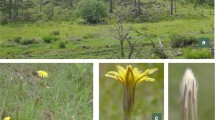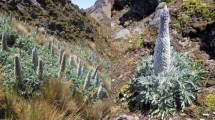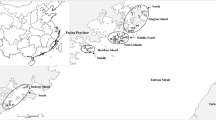Abstract
Twenty-two loci were re-evaluated to assess genetic variation and differentiation in three natural populations (two from Gran Canaria and one from Tenerife) of Gelidium (G. canariensis and G. arbuscula). The new data using exclusively the diploid subpopulation gene frequencies confirm that dispersal was restricted over short distances for the two species, but contrary to previous conclusions, the data reveal that these two closely related species differed markedly by their mating systems and patterns of genetic differentiation. Genetic differentiation among populations was twice as high in G. arbuscula as in G. canariensis. It was confirmed that the mean way of reproduction is asexual in G. arbuscula and a discussion included as to how clonal propagation may explain the difference in haploid and diploid allele frequencies in this species. There was no evidence for asexual reproduction in G. canariensis. Heterozygote deficiency could be explained simply by spatial sub-structuring within populations. The importance of the sampling design in determining the level and pattern of genetic differentiation within a species is discussed.
Similar content being viewed by others
References
Benzie JAH, Price IR, Ballment E (1997) Population genetics and taxonomy of Caulerpa (Chlorophyta) from the great barrier reef, Australia. J. Phycol. 33: 491-504.
Cheney DP, Babbel GR (1978) Biosystematic studies of the red algal genus Eucheuma. 1. Electrophoretic variation among Florida populations. Mar. Biol. 47: 251-264.
Coyer JA, Robertson DL, Alberte RS (1994) Genetic variability within a population and between diploid/haploid tissue of Macrocystis pyrifera (Phaeophyta). J. Phycol. 30: 545-552.
Fujio Y, Kodaka PL, Hara M (1985) Genetic differentiation and amount of genetic variability in natural populations of the haploid laver Porphyra yezoensis. Jap. J. Genet. 60: 347-354.
Goudet J (1995) Fstat Version 1.2. A computer program to calculate F-statistics. J. Hered. 86: 485-486.
Goudet J, De Meeüs T, Day AJ, Gliddon C (1994) The different levels of population structuring of dogwhelks, Nucella lapillus, along the south Devon coast. In Beaumont A (ed.), Genetics and Evolution of Aquatic Organisms. Chapman & Hall, London, UK 81-95.
Lewis PO, Zaykin D (1997) Genetic Data Analysis: Computer program for the analysis of allelic data. Version 1.0. Free program distributed by the authors over the internet from the GDA Home Page at http://chee.unm.edu/gda/software.
Lindstrom SC (1993) Inter-and intrapopulation genetic variation in species of Porphyra(Rhodophyta: Bangiales) from British Columbia and adjacent waters. J. appl. Phycol. 5: 53-62.
Lu TT, Williams SL (1994) Genetic diversity and genetic structure in the brown alga Halidrys dioica(Fucales: Cystoseiraceae) in southern california. Mar. Biol. 121: 363-371.
Nei M (1978) Estimation of average heterozygosity and genetic distance from a small number of individuals. Genetics 89: 583-590.
Raymond M, Rousset F (1995) GENEPOP (version 1.2): population genetics software for exact tests and eucumenism. J. Hered. 86: 248-249.
Rousset F, Raymond M (1997) Statistical analyses of population genetic data: new tools, old concepts. Trends Ecol. Evol. 12: 313-317.
Sosa PA, Garcia-Reina G (1992) Genetic variability and differentiation of sporophytes and gametophytes in populations of Gelidiutn arbuscula (Gelidiaceae: Rhodophyta) determined by isozyme electrophoresis. Mar. Biol. 113: 679-688.
Sosa PA, Garcia-Reina G (1993) Genetic variability of Gelidium canariensis(Rhodophyta) determined by isozyme electrophoresis. J. Phycol. 29: 118-124.
Wattier R, Dallas JF, Destombe C, Saumitou Laprade P, Valero M (1997) Single locus microsatellites in Gracilariales (Rhodophyta): high level of genetic variability within Gracilaria gracilisand conservation in related species. J. Phycol. 33: 868-880.
Weir BS, Cockerham CC (1984) Estimating the F-statistics for the analysis of population structure. Evolution 38: 1358-1370.
Williams SL, Di Fiori RE (1996) Genetic diversity and structure in Pelvetia fastigiata(Phaeophyta: Fucales): does a small effective neighborhood size explain fine-scale genetic structure. Mar. Biol. 126: 371-382.
Wright S (1965) The interpretation of population structure by F-statistics with special regard to systems of mating. Evolution 19: 395-420.
Author information
Authors and Affiliations
Rights and permissions
About this article
Cite this article
Sosa, P.A., Valero, M., Batista, F. et al. Genetic structure of natural populations of Gelidium species: A re-evaluation of results. Journal of Applied Phycology 10, 279–284 (1998). https://doi.org/10.1023/A:1008092023549
Issue Date:
DOI: https://doi.org/10.1023/A:1008092023549




